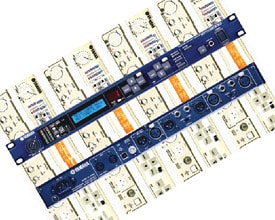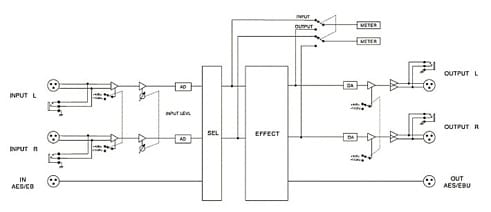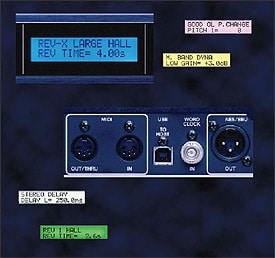Live Sound Magazine Test Drives the SPX2000
By Sully For me, reading a signal processing review goes something like this "blah, blah, blah deep, rich, and defined blah, blah, blah detailed and shimmering blah blah, blah everybody who doesn't own this might as well be a neutered poodle." Recently the editor of this esteemed publication talked me into taking a look at the new Yamaha SPX2000 digital effects unit. And, by the way, "would I be interested in sharing my findings with our readers?" My joy was undetermined, to say the least. Don't get me wrong I love the Japanese. I swear to this day that the gated reverb program in the original SPX90 got a band I was working with signed. But you know if you don't write ad copy for a living, how exciting can an electric can opener be to talk about? I guess it depends on how hungry you are.
I love old Volkswagen Beetles, bone stock on the outside, fully tweaked to be bulletproof on the inside. I love tearing old rack gear apart and making it better, using modern components. I opened up an old BSS 310 once with the full intention of re-chipping it to make it quieter, faster, stronger you get the point. It wasn't important that I had no clue what I was doing at the time, the idea of it made me giggle. This being my thought process, I pulled open the box swaddling Yamaha's new SPX2000, and two things popped into my head: the new BMW Mini and Flubber. On the spot, a new adage was born: "Keep that which made the old product classic, but give it airbags and Eddie Murphy." Excellent. I like it already. Do we need to do the numbers? I hate this part, but you might be reading this on a bus and need something to do while the band is critiquing a board tape you made. Here. Synopsis. Read. The heart of the SPX2000 is the 96-kHz audio DSP chip, with 32-bit internal processing (58-bit accumulator) which offers an abundance of processing power for the box's advanced effect algorithms. The 24-bit, 128-times oversampling A/D-D/A converters provide a dynamic range of 106 dB and a flat frequency response from 20 Hz to 20 kHz (0 dB + 1.0, -3.0) at 48 kHz, and 20 Hz to 40 kHz (0 dB + 1.0, -3.0) at 96 kHz. Internal clock configures to 44.1 kHz, 48 kHz, 88.2 kHz or 96 kHz. SPX2000 rear-panel includes for analog connection XLR type (w/latch) and 1/4-inch left and right input and output connectors, both with +4 dBU/-10 dBu selector switch. Digital connections are secured with AES/EBU XLR type I/O connectors and BNC word-clock input connector. Also MIDI IN, OUT/TROUGH and USB TO HOST connectors are provided for remote control and data management using computers, digital consoles or any MIDI device. Foot switch connector for effect tempo control is placed on the front panel. O.K., great, glad we could offer the same information available on the manufacturer's web site. On with the circus.
The following is not a fairy tale of someone sitting in a sanitized studio, tracking excellent players and listening to this thing's output on a pair of Genelecs. Rather, it's probably what most people I know would do with this box slap it in a rack and take it on the road. So we did. On this particular run, we had the pleasure of carrying production from Clair Bros. If you have not enjoyed the experience yet, I suggest you do so promptly. You know that dream you have where everything works all the time, right out of the box, and the PA company treats you as if you mix Sting? Go see Ralph and Scooter and the Clair crew in Nashville it's like Disney. But I digress. I was the system tech for a small tour that was running a pair of Yamaha DM2000 digital boards for house and monitors. The front-of-house guy indulged me by saving space for the SPX2000 and promised to try it as a minor second snare reverb if he got a minute to play with it. Me, I was mixing the opener, a strummy acoustic singer. We tied the unit, digitally, into the house system's DM2000 using the AES/EBU ins and outs. As suggested by Clair, we did this with straight mic cable less than 20 feet long. It worked flawlessly. I'm holding my ears now. Anybody who wants to get involved in a "premium 110-ohm wire only" discussion needs to go vent on the Live Audio Board (LAB). The first couple of nights we kinda poked at the unit half-heartedly with a stick, but didn't really use it. It looked nifty, but we had a groove to get into and God knows we weren't going to take time to read the manual. About five nights in, the front-of-house guy for the headliner decided to try it as a vocal reverb on a ballad. He chose "Breathy Reverb," dialed it in, rolled up the return and there, I swear to you without any exaggeration, is my favorite ballad program from a Lexicon 300. We're casual about it. That's nice, etc. Show goes off, we load out. Later, I'm walking to the back lounge of the bus and he looks up from playing Halo and says, "know what (lead singer of the band) said to me? He wanted to know what reverb we had on him tonight and told me to go buy one. What do you think that's about?" "From the stage he hears this?" I ask. "Yeah says he had his 'ears' out and can hear the house when he does that. All I know is he knew we added something different, he really dug it and he wants one." The next day before soundcheck, we were fumbling over each other like limbless hamsters. Without actually reading the manual, we managed to push every button and twist the big pretty knob a billion times while checking out the unit. (One billion is the official number " we made our intern count.) Programs from the SPX90 thru the SPX990 are pretty much all there. You could walk up to this thing at a festival and start punching buttons like you've done it a thousand times. In reality, you have; instinctively, it's all of its predecessors combined. (Except for the SPX900 that thing was, well, no comment.)
Without belaboring the point, we used the SPX2000 for just about everything possible for the rest of the run. Vocal reverbs, drum plates, the nifty
"Rev X" algorithms
I think we managed to put every input, including
overheads, through that thing at one time or another.
After we settled on which program was being used during which song, I tied a MIDI cable onto it and did program changes via the DM2000 console's scene recall. It was almost invisible after that. All the proper parameters changed with the scene recall and the thing was so quiet, we could rarely tell whether the returns were up or down. In fact, just after the tour I had to do a little showcase gig. The stage was quite loud so I flipped the SPX2000 in line and delayed the house to the backline with it. No noise penalty, no fidelity loss. (Try that with a 990.) The SPX2000 also has that old chestnut "freeze" almost three seconds worth of sampling which came in handy in a pinch. During a corporate event, I sampled an announcer saying, "Please take your seats," something I normally would record in (Syntrillium) Cool Edit Pro as a WAV file. (My computer had been co-opted for a mission I won't speak of here, but let's just say THE PROMPTER GUY TOOK IT AS THE BACKUP HE FORGOT TO BRING.) Anyway, that's not important. The point is, I simply triggered the sample whenever I needed to start the show. Worked like a charm. Eventually, I had to return the demo piece that had been so kindly loaned to us by Bauder Audio in Philadelphia. They had agreed to let us play with it for two weeks; we wound up paying them to keep it out for the whole tour and then some. I must say, I could have continued to use it for dozens of other things besides simply outboard effects processing. It turned out to be the proverbial Gerber with an IEC. After the unit had been sealed up to ship back to Bauder, I put it in my car to take it to UPS. Right before leaving, I grabbed a box knife and opened the box back up, took a quick picture, and then re-taped it closed. I'm making a collage of useful things. So far I have pictures of two Land Rovers, my Midas XL-42 and one Yamaha SPX2000. Sully currently mixes emerging country artist Joe Nichols and contributes "The Life" column to Live Sound. He can be reached at Steer_The_Wave@Bellsound.net. Reprinted with permission. Live Sound International, August 2004. |




